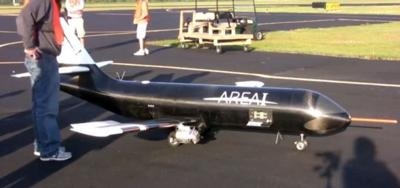Fri, Dec 20, 2013
Scale Model Of The Airliner Serves As Testing Platform For New Technologies
Georgia based company Area-I turned to Solid Concept’s manufacturing solutions for their 737 scale model unmanned aerial vehicle (UAV) PTERA (pictured). PTERA’s purpose is to provide a low-cost testing platform for new control and monitoring technologies.

Solid Concepts provided multiple Selective Laser Sintered (SLS) 3D Printed components for Area-I’s scale 737 model reducing time and assembly work for the engineering team at Area-I. The 3D Printed components for PTERA, which stands for Prototype Technology Evaluation Research Aircraft, include fuel tank, ailerons, control surfaces and flaps.
SLS 3D Printing works via a bed of powdered nylon and a CO2 laser which sinters the nylon in consecutive layers until a final product is achieved. Originally, Area-I hand-built the ailerons for PTERA; however, “before we had Solid Concepts build the ailerons out of SLS it took us 24 man-hours,” says CEO of Area-I Nick Alley. “When we grew the ailerons with SLS, they were designed, built and assembled on PTERA within three days. SLS is easy to work with, installs quickly, is efficient and, from an aesthetic standpoint, produces parts that are gorgeous.” The control surfaces incorporated all hinges and mounting structures into the initial build, eliminating costly and time-consuming post-processing as well as eliminating the extra weight of bulky additives for attaching features via traditional methods.
“Additive manufacturing has completely changed the way we design aircraft,” says Alley. “We used to shy away from certain complex designs, opting for structures that are more basic. With additive manufacturing, we can now create even the most complicated designs. It has completely opened up design capabilities that we would not be able to make with any other manufacturing method.”
PTERA’s fuel tank also benefitted from SLS, with anti-slosh baffles designed and built directly into the inside of the tank which significantly aided in the balance and flight length of PTERA. “With the latest build technologies available, we’re now able to get parts for our aircraft faster than ever before,” says Alley. Normally fuel tanks are built out of steel or other metals, but Area-I was able to 3D Print PTERA’s tank with SLS and coat the inside of the tank with a special sealant resulting in a much faster turnaround and far lighter fuel tank.
(Image captured from Solid Concepts YouTube video)
More News
Aero Linx: The American Society of Aerospace Medicine Specialists (ASAMS) The Society is a non-profit organization created to serve as a voice for and represent the professional ne>[...]
Class C Service This service provides, in addition to basic radar service, approved separation between IFR and VFR aircraft, and sequencing of VFR aircraft, and sequencing of VFR a>[...]
Have A Story That NEEDS To Be Featured On Aero-News? Here’s How To Submit A Story To Our Team Some of the greatest new stories ANN has ever covered have been submitted by our>[...]
Also: ERAU Uses UAVs, P550 Group 2 UAS, Starship’s Florida Launches, NASA Missions Chopped The Air Force has put out a call to commission a one-to-one copy of the Iranian-des>[...]
Classic Klyde Morris From 11.07.16 (and Remembering Bob...) FMI: www.klydemorris.com>[...]
 ANN's Daily Aero-Linx (08.27.25)
ANN's Daily Aero-Linx (08.27.25) ANN's Daily Aero-Term (08.27.25): Class C Service
ANN's Daily Aero-Term (08.27.25): Class C Service ANN FAQ: Submit a News Story!
ANN FAQ: Submit a News Story! Airborne-NextGen 08.26.25: Iran UAV Knockoffs, X-37B Spaceplane, Army Training
Airborne-NextGen 08.26.25: Iran UAV Knockoffs, X-37B Spaceplane, Army Training Classic Klyde Morris (08.25.25)
Classic Klyde Morris (08.25.25)



